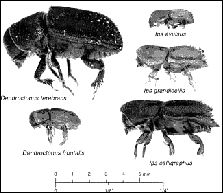The best beetle patterns are generic and do not represent a specific
variety. For warm waters it is generally a good idea to start with and
black or rust colors in sizes 8-12. For cold water streams (yes, trout
eat them too) a size 10-16 can be used in lieu of a strike indicator.
Beetles are six legged creatures, but fish probably don't count. Some
patterns (not the one below) choose to use only chenille or hackle
underbodies with no legs, but legged patterns seem to catch more fish.
Fishing the fly: Beetles generally don't fall into the middle
of a water body, and fish will expect them to be near the bank,
especially by overhangs. Find a likely looking fall-in area and
concentrate there. The fly should be delivered onto the water
with a very slight "plop" and roll casting is excellent for providing
the correct landing force to the fly. Strikes normally come right
after the fly is delivered. If not, a few small finger strips to animate
the fly are all that should be used (strip-pause-strip-pause) and then
lift the fly from the water as if it flew away before delivery again
(which can be to the exact same location).
GENERIC BEETLE PATTERN
Hook: Dai-Riki 070 (or equivalent) Size 12-18.
Thread: Flat waxed nylon in a color to match foam .
Body: Fun Foam.
Underbody: Chenille.
Legs: Round rubber or silicone skirting
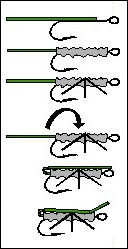 1. Wrap entire shaft of hook with thread to provide base for
other materials.
1. Wrap entire shaft of hook with thread to provide base for
other materials.
2. Cut a rectangular strip of foam approximately 1.5 times the
width of the hook gap (equal to for larger hooks). Trim one
end to a point.
3. Tie in point of foam at middle of the shaft. Make sure the
tie-in tacks down all of the angled portion of the point so that
only rectangular area is left.
4. Bring thread to the hook shaft above the bend.
5. Tie in chenille. Wrap chenille forward or to 1/4" behind eye.
6. Tie in three strands of rubber leg material or silicone skirting
material by doing the following:
a. Lay legs on top of and parallel to hook shank.
b. Make two snug but not tight threadwraps over the center of the legs.
c. Turn the legs 90 degrees.
d. Using 3 figure 8 wraps tack down the legs which should now face
perpendicular to the shank.
e. Pull back the two rear most legs and make a wrap of thread
in front of them.
f. Pull back the four rear most legs and make a wrap in front of them.
7. Move the thread to the space 1/4 inch behind the hook eye.
8. Pull the foam tightly over the chenille and tack down with thread
wraps behind the hook eye and whip finish.
9. Trim the excess foam.
10. (optional) Cut out a dot of highly visible foam with a standard
hole punch. Super glue this to the top of the beetle shell.
10. Coat the entire top of the beetle and thread wraps by hook
eye with Hard As Nails.
EXTRA DOTS:
Foam beetles can disappear in the surface film. Extra foam dots
can be added to the back of the beetle with super glue or
zap-a-gap to allow the fisherman to see it better. The dots
don't discourage the fish.
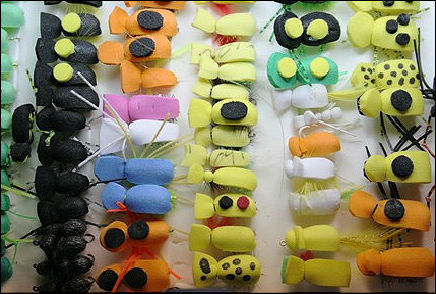 ~ Bob
~ Bob
About Bob:
Robert Lamar Boese has fly fished for five decades. He is an
environmental negotiator, attorney and educator who has provided
environmental legal services for more than thirty-three years including
active duty with the U.S. Coast Guard and Department of Justice. He is a
well known fly tyer with several unique patterns to his credit. He has
developed and authored federal and state regulatory programs
encompassing a broad spectrum of environmental disciplines, has
litigated environmental matters at all levels of the federal and state
court systems, and is a qualified expert for testimony in environmental
law. He has authored over 60 published text chapters, comments or
articles on environmental matters, is a member of the Colorado, District
of Columbia and Louisiana Bar Associations, and is a certified mediator.
In addition to his legal practice, Mr. Boese has been a high school
teacher, an associate professor of Environmental Law and Public Health,
has authored numerous fiction and sports publications, and is a softball
coach and nationally certified volleyball referee. He is the president
of the Acadiana Fly Rodders in Lafayette, Louisiana and editor of
Acadiana on the Fly. He has been married for thirty years and is the
father of two fly fishing girls (25 and 21). For additional information
contact: Boese Environmental Law, 103 Riviera Court, Broussard, LA 70518
or call 337.856.7890 or email coachbob@ymail.com.
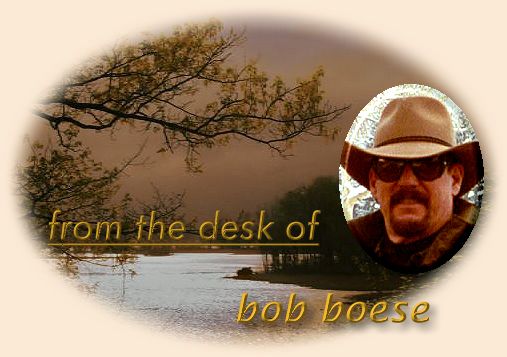
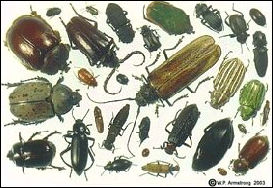
 1. Wrap entire shaft of hook with thread to provide base for
other materials.
1. Wrap entire shaft of hook with thread to provide base for
other materials.

